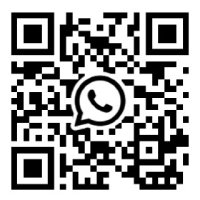Understanding Interleaved 2 of 5 barcode
What is Interleaved 2 of 5 Barcode?
The Interleaved 2 of 5 Code (ITF)—short for Interleaved, Two, and Five—is a continuous, variable-length, self-checking, bidirectional barcode symbology invented by Intermec Corporation (USA) in 1972. It encodes data using both bars and spaces and gets its name from the interleaving of bar and space patterns between character pairs. The character set includes only digits (0–9). Initially used in warehousing and heavy industry, it was adopted for transport packaging in the US in 1981. Japan standardized and implemented it in 1987 for storage and shipping unit identification. Today, it is the standard barcode for logistics units in EAN specifications.
Characteristics of Interleaved 2 of 5 Barcode
- Numeric Only: It only supports numbers (0–9).
- High Density: Compact and ideal for environments with space constraints.
- Interleaved Encoding: Each digit pair is combined into a single pattern of bars and spaces.
- Even Number of Digits: Because it encodes in pairs, the total number of digits must be even. If it's odd, a zero is usually added to the front.
Application of Interleaved 2 of 5 Barcode
Interleaved 2 of 5 is widely used in:
- Warehousing and logistics
- Distribution and packaging
- Carton labeling
- Inventory tracking
- Retail shelf labeling
It's especially favored in industrial settings where compact, fast-scanning codes are essential.
Structure of an Interleaved 2 of 5 Barcode
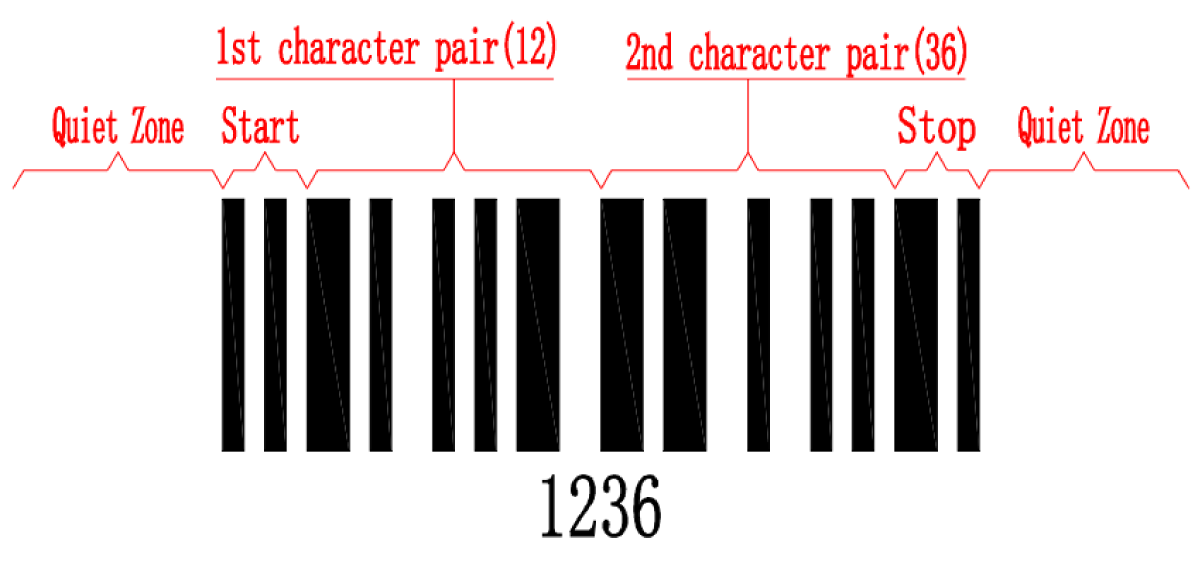
An Interleaved 2 of 5 barcode consists of the following parts:
- Left Quiet Zone
- Start character: Narrow bar + narrow space + narrow bar + narrow space (two narrow spaces serve no real purpose)
- One or more character pairs: May include an optional check digit (in the example image, the final "6" is the check digit)
- Stop character: Wide bar + narrow space + narrow bar (one narrow space has no actual function)
- Right Quiet Zone
The left and right quiet zones should each be at least 10 times the width of a narrow bar or space.
Encoding Method of an Interleaved 2 of 5 Barcode
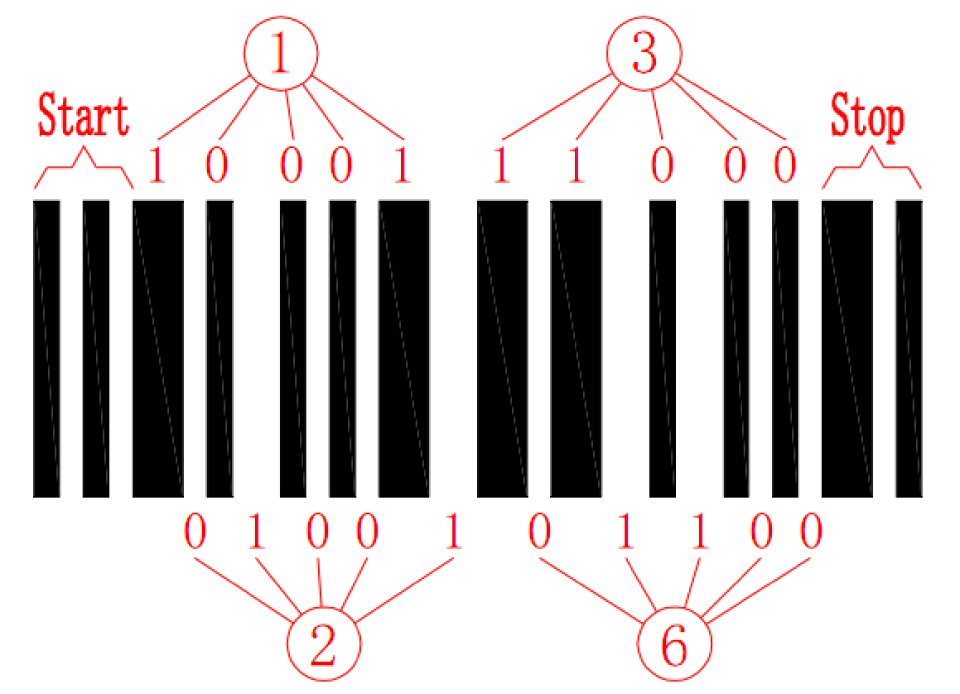
Each Interleaved 2 of 5 character consists of five elements (bars or spaces), two wide (representing binary "1") and three narrow (representing binary "0"). Wide elements are 2–3 times the width of narrow ones.
The "interleaved" aspect refers to how each digit pair is encoded: one digit is encoded into the bars, and the other into the spaces. For every 10 elements (5 bars + 5 spaces), one full character pair is encoded.
Important: The total number of digits must be even. If not:
- A leading zero is added if the input has an odd number of digits and no check digit is used.
- A leading zero is also added if the input has an even number of digits and a check digit is used.
Encoding table of Industrial 2 of 5:
| Digit | Binary Code | Logical Form |
|---|---|---|
| 0 | 00110 | nnwwn |
| 1 | 10001 | wnnnw |
| 2 | 01001 | nwnnw |
| 3 | 11000 | wwnnn |
| 4 | 00101 | nnwnw |
| 5 | 10100 | wnwnn |
| 6 | 01100 | nwwnn |
| 7 | 00011 | nnnww |
| 8 | 10010 | wnnwn |
| 9 | 01010 | nwnwn |
Note: "1" or "w" = wide, "0" or "n" = narrow.
Although denser than Code 39, Interleaved 2 of 5 does not have the same level of data security. Therefore, it's recommended to use a check digit.
How to Calculate the Check Digit of an Interleaved 2 of 5 Barcode?
Interleaved 2 of 5 can include an optional check digit based on the Mod 10 (MOD10) algorithm. This method is the same as that used in Industrial 2 of 5.
Example: Encoding 1234
Since the total becomes 5 digits after adding a check digit, we prepend a zero → 01234.
Calculation Steps:
1. Add digits in odd positions and multiply the sum by 3:
(4 + 2 + 0) × 3 = 18
2. Add digits in even positions:
3 + 1 = 4
3. Sum both results and take the modulo 10:
(18 + 4) mod 10 = 2
4. Subtract from 10 to get the check digit:
10 – 2 = 8
Note: If the result is 10, the check digit becomes 0.
So, the check digit for 1234 is 8.
Bearer Bars
Interleaved 2 of 5 barcodes can include bearer bars—extra bars either surrounding the code or placed above/below the main bars.
Why use bearer bars?
- They prevent distortion when printing directly on corrugated boxes using flexographic printing plates, which may bend.
- They protect against angled scanning, which could cause partial reading.
Types of bearer bars:
- Box Bearer Bars (data outside the frame)
- Box Bearer Bars (data inside the frame)
- Vertical Bearer Bars (top and bottom lines only)

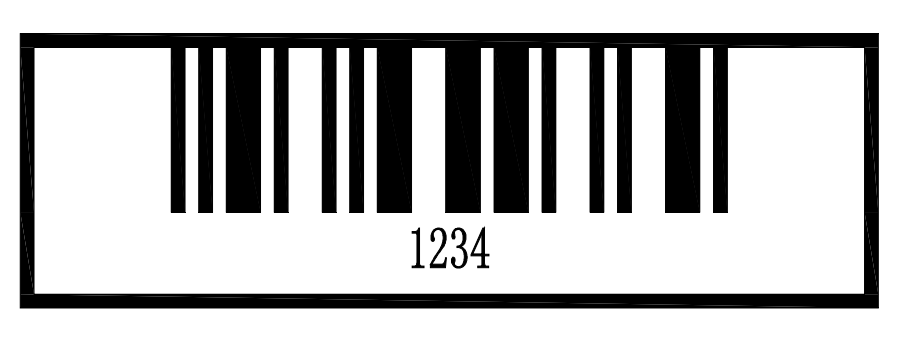
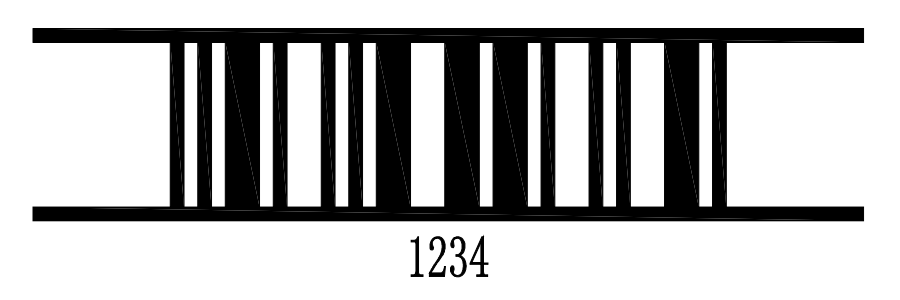
Advantages of Interleaved 2 of 5
- More compact than standard 2 of 5 codes (uses both bars and spaces).
- Self-checking ability (can be used with or without check digits).
- High density, suitable for industrial uses.
Disadvantages of Interleaved 2 of 5
- Numeric-only: Cannot encode letters.
- Less secure than other symbologies like Code 128, unless a check digit is added.


